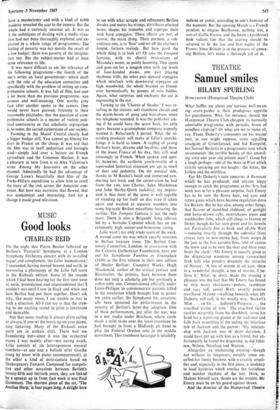Good looks
CHARLES REID
On the night that Pierre Boulez followed up Berlioz's 'Fantastic' Symphony at a London Symphony Orchestra concert with its so-called sequel and complement, the Lelio 'monodrama,' I succeeded, having moved heaven and earth, in borrowing a photocopy of the Lill° full score in the Richault edition. Some of the sounds which I had been hearing for the first time were so eerie, preordained and unprecedented that 1' couldn't rest until I saw in black and white just how Berlioz had put them together. Don't ask why, like many more, I am unable to rest in such a situation. All I can say is that the era*" ing to see exciting sound in print is inveterate
and incurable. •i•
Not that score reading is always plain sailing or always, if you set the music up on your piano, easy tinkering. Many of the Richault voice parts are in archaic clefs. These had me floundering but—since it was the orchestral staves I was mainly after—not caring much. Lao consists of six heterogeneous musical numbers—at one end a ballade after Goethe (sung by tenor with piano accompaniment), at the other a kind of mini-cantata based on Shakespeare's Tempest. Cothposed for competi- tive and other occasions between Berlintes twenty-fifth and thirtieth years, they are linked by a speaker up in front (last week it was Paul Daneman). The shortest piece of the six, 'The Aeolian Harp,' is four pages long. A delight here to see with what scruple and refinement Berlioz divides and mutes his strings, distributes plucked
notes, shapes his tremolos and asperges them with harp arpeggios. These effects are not, of course, the main thing. Their purpose, a sub- ordinate one, is to 'float' and set off the clarinet's limpid, forlorn melody. But how good the whole thing is to look at! Or take the Tempest fantasia, with its choral invocations of Miranda's name, so palely haunting. This opens and goes on for a longish time with top levels of four-handed piano, one pair playing rhythmic trills, the other pair upward arpeggios which interlock with downward arpeggios on high woodwind, the whole braided or filmed- over harmonically by groups of solo fiddles. Again, what surprises and enchants the ear is engrossing to the eye.
Turning to the 'Chorus of Shades,' I was re- velling in the sinister, soft trombone chords and the doom-boom of gong and bass-drum when my telephone sounded. It was the publisher ask- ing if he 'could have the score back, his only spare, because a gramophone company urgently wanted it. Reluctantly I parted. What the re- cording producer will make of L6lio's speechi- fyings it is hard to know. A ragbag of young Berlioz's hates, dreams and loyalties, and those of the jeune France of his day, they still read amusingly in French. When spoken and spot- lit, however, the aesthetic youth-revolts of a superseded historical situation are apt to smell of dust and pedantry. On the musical side, thanks to M Boulez's lucid and immersed con- ducting last week and the cooperation he had from the tso, tso Chorus, John Mitchinson and John Shirley-Quirk (soloists), my impres- sion is that most of the score is well capable of standing up for itself on disc even if taken apart and worked as separate numbers into some big-scale Berlioz miscellany featuring the rarities. The Tempest fantasia is not the only must. There is also a Brigands' Song (chorus led by a baritone Captain) which has an un- commonly high roister-and-brimstone rating.
Mk wasn't my only study-score of the week. A second came my way which equally amounts to Berlioz treasure trove. The Berlioz Cen- tenary Committee, London, in association with the Calouste Gulbenkian Foundation, have put out his Symphonic Funebre et Triomphak (1840) as the first volume in their new edition of Hector Berlioz: Complete Works. Hugh Macdonald, author of the critical preface and Bilrenreiter, the printers, have between them done not only a scholarly job but positively a coffee-table one. Commissioned officially under Louis-Philippe to commemorate patriots killed in the revolution which brought him to power ten years earlier, the Symphonie has occasion- ally been uprooted for performance in the country of Berlioz's latter-day adoption. One of these performances, just after the war, was in a BBC studio under Beecham, whose circle made a mild to-do over the tenor-trombone he had brought in from a Midlands pit band to play the Funeral Oration solo in the middle movement. This trombone harangue is infallibly tedious or comic, according to one's humour of the moment. But the opening March is a French pendant to elegiac Beethoven, nothing less, a sort of Gallic Eroica. and the finale (Apotheose) such valiant fun that the scoring should be adapted to fit the last and first nights of the Proms. Since Britain is in the process of annex- ing Berlioz, let's make a thorough job of it.










































 Previous page
Previous page